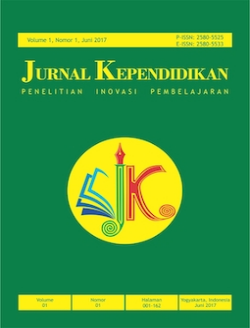The use of besmart to improve students' self-discipline in community economy course
Downloads
Downloads
Balaji, R., Al-Mahri, F., & Malathi, R. (2016). A perspective study on content management in e-learning and m-learning. http://arxiv.org/abs/1605.02093.
Baroroh, K., Lestari, B., & Suwarna. (2016). Utilization of e-learning in the class of economics teaching and learning strategy for students of the Economics Education Study Program in 2015. International Conference on Teacher Education and Profesional Development (InCoTEPD), 354-362.
Cappel, J. J., & Hayen, R. L. (2004). Evaluating e-learning: A case study. Journal of Computer Information Systems, 44(4), 49-56.
Costley, J., & Lange, C. (2017). The mediating effects of germane cognitive load on the relationship between instructional design and students' future behavioral intention. Electronic Journal of E-Learning, 15(2), 174-187.
Costley, K. C. (2018). Character education: A growing need in American Schools. Journal of Chemical Information and Modeling, 53(9), 1689-1699.
Gaebel, M., Kupriyaova, V., Morais, R., & Colucci, E. (2014). E-learning in European higher education institutions: Results of a mapping survey conducted in October-December 2013. European University Assosiation (Issue December). www.eua.be.
Gagnon, J. C., Gurel, S., & Barber, B. R. (2017). State-level analysis of school punitive discipline practices in Florida. Behavioral Disorders, 42(2), 65-80. https://doi.org/10.1177/0198742916688652
Gorbunovs, A., Kapenieks, A., & Cakula, S. (2016). Self-discipline is a key indicator of improving learning outcomes in an e-learning environment. Procedia-Social and Behavioral Sciences, 231, 256-262. https://doi.org/10.1016/j.sbspro.2016.09.100.
Hamdan, N. A., Mohamad, M., & Shaharuddin, S. (2017). Hypermedia reading materials: Undergraduate perceptions and features affecting their reading comprehension. Electronic Journal of E-Learning, 15(2), 116-125.
Hartanto, W. (2016). Penggunaan e-learning sebagai media pembelajaran. Jurnal Pendidikan Ekonomi: Jurnal Ilmiah Ilmu Pendidikan, Ilmu Ekonomi dan Ilmu Sosial, 10(1). https://jurnal.unej.ac.id/index.php/JPE/article/view/3438.
Moleong, L. J. (2005). Metodologi penelitian kualitatif. Remaja Rosdakarya.
Kemmis, S., McTaggart, R., & Nixon, R. (2014). Action research planner book. Springer Science+Bussiness Media Singapore.
Khan, A., Egbue, O., Palkie, B., & Madden, J. (2017). Active learning: Engaging students to maximize learning in an online course. Electronic Journal of E-Learning, 15(2), 107-115.
Kiryakova-Dineva, T., Levunlieva, M., & Kyurova, V. (2017). Iphras as an e-learning platform for idiomatic competence. Electronic Journal of E-Learning, 15(2), 137-143.
Littlejohn, D. (2019). Disciplining the graphic design discipline: The role of external engagement, mediating meaning, and transparency as catalysts for change. Art, Design & Communication in Higher Education, 16(1), 33-51.
Madya, S. (2007). Penelitian tindakan kelas. Alfabeta.
Makransky, G., Bonde, M. T., Wulff, J. S. G., Wandall, J., Hood, M., Creed, P. A., Bache, I., Silahtaroglu, A., & Ní¸rremí¸lle, A. (2016). Simulation based virtual learning environment in medical genetics counseling: An example of bridging the gap between theory and practice in medical education. BMC Medical Education, 16(1), 1-9. https://doi.org/10.1186/s12909-016-0620-6.
Moazami, F., Bahrampour, E., Azar, M. R., Jahedi, F., & Moattari, M. (2014). Comparing two methods of education (virtual versus traditional) on learning of Iranian dental students: A post-test only design study. BMC Medical Education.
Moore-Adams, B. L., Jones, W. M., & Cohen, J. (2016). Learning to teach online: A systematic review of the literature on K-12 teacher preparation for teaching online. Distance Education, 37(3), 333-348. https://doi.org/10.1080/01587919.2016.1232158.
Nicolau, N. G., & Popescu, M.-L. (2013). E-Learning innovations in higher education. Romanian Review of Social Sciences, 4, 34-47.
Pandey, U. C., & Indrakanti, V. (2017). Open and distance learning initiatives for sustainable development. IGI Global. https://doi.org/10.4018/978-1-5225-2621-6
Pituch, K. A., & Lee, Y. (2006). The influence of system characteristics on e-learning use. Computers & Education, 47(2), 222-244. https://doi.org/10.1016/j.compedu.2004.10.007.
Pol, E. (2013). Innovation and economic education: An integration. Journal of Economics and Economic Education Research, 14(2), 21-36.
Prensky, M. (2003). Digital game-based learning. ACM Computers in Entertainment, 1(1), 1-4.
Risabethe, A., & Astuti, B. (2017). Pengembangan media pembelajaran untuk meningkatkan motivasi belajar dan karakteristik semangat kebangsaan siswa kelas V SD. Jurnal Pendidikan Karakter, 1(8).
Robinson, H. A., Sheffield, A., Phillips, A. S., & Moore, M. (2017). Introduction to teaching online: Usability evaluation of interactivity in an online social constructivist course. TechTrends: Association for Educational Communication &Technology, 6(61).
Ruman, Y. S., Kusumajati, D. A., & Gea, A. A. (2015). Effect of learning interest against learning motivation on character building courses at Binus University Jakarta. Advanced Science Letters, 21(7), 2332-2335.
Setyohadi, D. B., Aristian, M., Sinaga, B. L., & Hamid, N. A. A. (2017). Social critical factors affecting intentions and behaviours to use e-learning : An empirical investigation using technology acceptance model. Asian Journal of Scientific Research, 10(4), 271-280. https://doi.org/10.3923/ajsr.2017.271.280.
Simatupang, J. (2010). Pemanfaatan ICT (internet) menopang pembelajaran aktif di perguruan tinggi. https://johannessimatupang.wordpress.com/2010/11/19/pemanfaatan-ict-internet/
Smith, G. G., Torres-Ayala, A. T., & Heindel, A. J. (2008). Disciplinary differences in e-learning instructional design: The case of mathematics. Journal of Distance Education Revue De Leducation a Distance, 22(3), 63-88.
Sung, H. Y. (2010). Response to intervention: A catalyst for paradigm shift for 21st century education. The Journal of Educational Practice for Social Change, Fall 2010.
Surjono, H. D. (2008). Modul pelatihan e-learning UNY. UPT Puskom Universitas Negeri Yogyakarta.
Susanto, E., & Retnawati, H. (2016). Perangkat pembelajaran matematika bercirikan PBL untuk mengembangkan HOTS siswa SMA. Jurnal Riset Pendidikan Matematika, 3(2), 189-197.
Urh, M., & Jereb, E. (2014). Learning habits in higher education. Procedia - Social and Behavioral Sciences, 116, 350-355. https://doi.org/10.1016/j.sbspro.2014.01.220.
Vitoria, L., Mislinawati, M., & Nurmasyitah, N. (2018). Students' perceptions on the implementation of e-learning: Helpful or unhelpful? Journal of Physics: Conference Series, 1088, 012058.
Widoyoko, E., P. (2009). Evaluasi program pembelajaran panduan praktis bagi pendidik dan calon pendidik. Pustaka Pelajar.
The authors submitting a manuscript to this journal agree that, if accepted for publication, copyright publishing of the submission shall be assigned to JK. However, even though the journal asks for a copyright transfer, the authors retain (or are granted back) significant scholarly rights.
The copyright form should be signed originally and sent to the Editorial Office through email to jk@uny.ac.id
Download HERE

Jurnal Kependidikan by http://journal.uny.ac.id/index.php/jk is licensed under a Creative Commons Attribution-ShareAlike 4.0 International License.




























